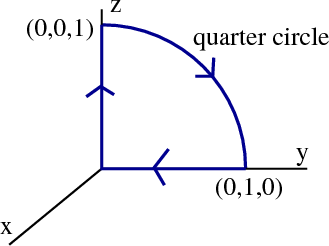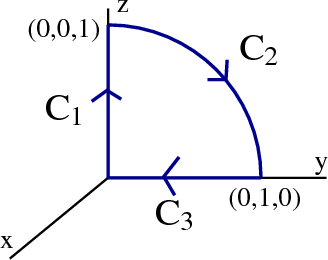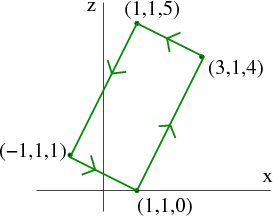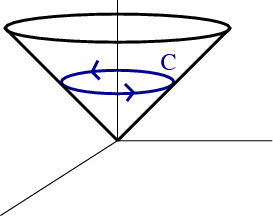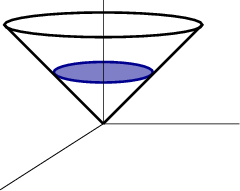Stokes' theorem examples
Stokes' theorem relates a surface integral of a the curl of the vector field to a line integral of the vector field around the boundary of the surface. After reviewing the basic idea of Stokes' theorem and how to make sure you have the orientations of the surface and its boundary matched, try your hand at these examples to see Stokes' theorem in action.
Example 1
Let $\dlc$ be the closed curve illustrated below.
For $\dlvf(x,y,z) = (y,z,x)$, compute \begin{align*} \dlint \end{align*} using Stokes' Theorem.
Solution: Since we are given a line integral and told to use Stokes' theorem, we need to compute a surface integral \begin{align*} \sint{\dls}{\curl \dlvf}, \end{align*} where $\dls$ is a surface with boundary $\dlc$. We have freedom to choose any surface $\dls$, as long as we orient it so that $\dlc$ is a positively oriented boundary.
In this case, the simplest choice for $\dls$ is clear. Let $\dls$ be the quarter disk in the $yz$-plane.
Given the orientation of the curve $\dlc$, we need to choose the surface normal vector $\vc{n}$ to point in which direction? By the right hand rule criterion, the normal vector should point toward the negative side of the $x$-axis.
We need to calculate the curl of $\dlvf$. We can calculate the curl as using the notation \begin{align*} \curl(\dlvf) &= \nabla \times \dlvf = \nabla \times (y,z,x)\\ & = \left| \begin{array}{ccc} \vc{i} & \vc{j} & \vc{k}\\ \displaystyle \pdiff{}{x} & \displaystyle \pdiff{}{y} & \displaystyle \pdiff{}{z}\\ y & z & x \end{array} \right|\\ &= \vc{i} \left(\pdiff{}{y} x - \pdiff{}{z} z\right) -\vc{j} \left(\pdiff{}{x} x - \pdiff{}{z}y\right)\\ &\quad+\vc{k} \left(\pdiff{}{x} z - \pdiff{}{y}y\right)\\ &= \vc{i} (-1) - \vc{j} (1) + \vc{k} (-1)\\ &= (-1, -1, -1) \end{align*}
Next, parameterize the surface (the quarter disk) by \begin{align*} \dlsp(r,\theta) = (0, r\cos\theta, r\sin\theta) \end{align*} for $0 \le r \le 1$ and $0 \le \theta \le \pi/2$.
Calculate the normal vector (we don't need to normalize it to the unit normal vector $\vc{n}$): \begin{align*} \pdiff{\dlsp}{r} &= (0, \cos\theta, \sin\theta)\\ \pdiff{\dlsp}{\theta} &= (0, -r\sin\theta, r\cos\theta)\\ \pdiff{\dlsp}{r} \times \pdiff{\dlsp}{\theta} &= \vc{i} (r \cos^2\theta + r \sin^2\theta) = r \vc{i} \end{align*}
Is the surface oriented properly? The normal vector points in the positive x-direction. But we need it to point it negative x-direction. Therefore, the surface is not oriented properly if we were to choose this normal vector.
To orient the surface properly, we must instead use the normal vector $\displaystyle\pdiff{\dlsp}{\theta} \times \pdiff{\dlsp}{r} = -r \vc{i}$.
At this point, we can already see that the integral $\sint{\dls}{\curl \dlvf}$ should be positive. The vector field $\curl \dlvf = (-1,-1,-1)$ and the normal vector $(-r,0,0)$ are pointing in a similar direction.
Now, we have all pieces together to compute the integral. \begin{align*} \dlint &=\sint{\dls}{\curl \dlvf}\\ &= \psintrnro{0}{1}{0}{\pi/2}{\curl \dlvf}{\dlsp}{r}{\theta}\\ &=\int_0^1 \int_0^{\pi/2} (-1,-1,-1) \cdot (-r, 0, 0) d\theta\, dr\\ &=\int_0^1 \int_0^{\pi/2} r d\theta\,dr = \frac{\pi}{4} \end{align*}
Double-check example 1
Just for verification, we can compute the line $\dlint$ directly.
We need to parametrize $\dlc$. We'll do it by dividing $\dlc$ into three parts.
We'll use the fact that \begin{align*} \dlint =\lint{\dlc_1}{\dlvf} + \lint{\dlc_2}{\dlvf} + \lint{\dlc_3}{\dlvf} \end{align*}
Recall $\dlvf(x,y,z) = (y,z,x)$
First we'll compute the integral over $\dlc_1$. Parameterize it by \begin{align*} \dllp(t) &= (0,0,t), \qquad 0 \le t \le 1. \end{align*} Since $\dllp'(t)=(0,0,1)$, we compute that \begin{align*} \dlvf(\dllp(t)) \cdot \dllp'(t) &= \dlvf(0,0,t) \cdot (0,0,1)\\ &= (0,t,0) \cdot (0,0,1)\\ &=0 \end{align*} Therefore, \begin{align*} \lint{\dlc_1}{\dlvf} &= \plint{0}{1}{\dlvf}{\dllp} =0. \end{align*}
The integral for $\dlc_3$ is similar. \begin{align*} \lint{\dlc_3}{\dlvf} = 0 \end{align*}
Last, we'll compute the integral over $\dlc_2$. Parameterize $\dlc_2$ as \begin{align*} \dllp(t) &= (0,\sin t,\cos t), \qquad 0 \le t \le \pi/2, \end{align*} so that $\dllp'(t) = (0, \cos t, -\sin t)$. We then compute \begin{align*} &\lint{\dlc_2}{\dlvf} = \plint{0}{\pi/2}{\dlvf}{\dllp} \\ &=\int_0^{\pi/2}\dlvf(0,\sin t,\cos t) \cdot (0, \cos t,-\sin t)dt\\ &=\int_0^{\pi/2} (\sin t, \cos t,0) \cdot (0, \cos t,-\sin t)dt\\ &=\int_0^{\pi/2} \cos^2t \, dt\\ &=\int_0^{\pi/2} \frac{1+\cos 2t}{2} dt\\ &= \frac{t}{2} + \left.\left.\frac{\sin 2t}{4} \right|_0^{\pi/2}\right. = \frac{\pi}{4}. \end{align*}
Therefore, \begin{align*} \dlint = \frac{\pi}{4} \end{align*} in agreement with our Stokes' theorem answer.
Example 2
We often present Stoke's theorem problems as we did above. We give a curve $\dlc$ and expect you to compute the surface integral over some surface $\dls$ with boundary $\dlc$. In general, one can pick many surfaces. (See this applet.) But, sometimes, there is a surface that is “obviously” the best one.
One special case where this is relatively easy is when $\dlc$ lies in a plane. This is especially easy when that plane is parallel to a coordinate plane, as in the following example. (We won't work out this example, but just discuss how to choose $\dls$).
Let's say you want to use Stokes' theorem to compute $\dlint$ where $\dlc$ is polygon path connecting the following points: (1,1,0), (3,1,4), (1,1,5), (-1,1,1)
Does this curve lie in a plane? Yes, in the plane $y=1$. The figure below is just the plane $y=1$.
If one coordinate is constant, then curve is parallel to a coordinate plane. (The $xz$-plane for above example). For Stokes' theorem, use the surface in that plane. For our example, the natural choice for $\dls$ is the surface whose $x$ and $z$ components are inside the above rectangle and whose $y$ component is 1.
Example 3
In other cases, a surface is given explicitly in the problem.
Compute $\dlint$, where $\dlc$ is the curve in which the cone $z^2=x^2+y^2$ intersects the plane $z=1$. (Oriented counter clockwise viewed from positive $z$-axis).
\begin{align*} \dlint = \sint{\dls}{\curl \dlvf} \end{align*} for what surface $\dls$?
In this case, there are two natural choices for the surface. You could use the portion of the plane or the portion of the cone illustrated below.
Let $P$ be the portion of the plane $z=1$ with $x^2+y^2 < 1$ with upward pointing normal. Let $Q$ be the portion of the cone $z^2=x^2+y^2$ with $0 < z < 1$ with upward angling normal.
How do $\sint{P}{\curl \dlvf}$ and $\sint{Q}{\curl \dlvf}$ compare? They are the same. (For both surfaces, $\dlc$ is a positive oriented boundary.)
Continue example: Let \begin{align*} \dlvf(x,y,z) = \left(\sin x - \frac{y^3}{3}, \cos y + \frac{x^3}{3}, xyz \right) \end{align*} Compute $\dlint$.
One can show that $\curl(\dlvf) = (xz,-yz,x^2+y^2)$.
Use surface $P$, parameterized by \begin{align*} \dlsp(r,\theta) = (r \cos\theta, r\sin\theta, 1) \end{align*} for $0 \le r \le 1, 0 \le \theta \le 2\pi$. Then normal vector is \begin{align*} \pdiff{\dlsp}{r} \times \pdiff{\dlsp}{\theta} = (0,0,r), \end{align*} which points in the correct direction, as mentioned above. \begin{align*} \sint{P}{\curl \dlvf} &=\int_0^1 \int_0^{2\pi} \curl(\dlvf(r\cos\theta,r\sin\theta,1)) \cdot (0,0,r) d\theta dr \\ &=\int_0^1 \int_0^{2\pi} (r\cos\theta, -r\sin\theta, r^2) \cdot (0,0,r) d\theta\, dr \\ &= \int_0^1 \int_0^{2\pi} r^3 d\theta\, dr\\ &= \int_0^1 2\pi r^3 dr = \frac{\pi}{2} \end{align*}
Thread navigation
Multivariable calculus
Math 2374
Notation systems
Similar pages
- The idea behind Stokes' theorem
- Proper orientation for Stokes' theorem
- The idea behind Green's theorem
- The definition of curl from line integrals
- Calculating the formula for circulation per unit area
- The integrals of multivariable calculus
- Length, area, and volume factors
- The idea of the curl of a vector field
- Subtleties about curl
- The components of the curl
- More similar pages
